Positive Health Online
Your Country

Dyspepsia and Yoga Therapy
by Shama (Sara) Palmer(more info)
listed in yoga, originally published in issue 182 - May 2011
Dyspepsia is a medical condition that an NHS survey has reported affects about 40% of the adult UK population. It is characterized by recurrent pain in the upper abdomen, heartburn, bloating, burping, gastric reflux, nausea and vomiting, burning or gnawing sensation due to hyperacidity in the gut, and weight loss.
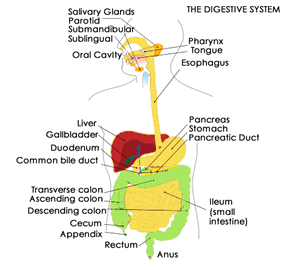
Digestive System
Causative factors can be overeating, wrong eating, irregular eating, being overweight, alcohol, smoking, emotional and/or mental stress. The presence of Helicobacter pylori (H pylori)in the stomach or duodenum can be a trigger for symptoms. The bacteria penetrate the mucous lining of the stomach and cause inflammation, which in some cases can lead to gastric ulcers. The bacteria can be detected through stool or breath tests or from a biopsy taken during an endoscopy. Endoscopy is a procedure in which a small, flexible tube called an endoscope is passed through the mouth into the body to view the oesophagus, stomach and duodenum.
When symptoms are chronic, a GP might recommend an endoscopy to determine if there are signs of disease such as ulcers or Helicobacter pylori. If dyspepsia is diagnosed, proton pump inhibitors or H2 blockers are likely to be prescribed to inhibit acid production in the gut. Where H. pylori and ulcers are present, a combination of antibiotics and acid suppressants might be prescribed. However, long-term (one year or more), high dosage use of proton pump inhibitors can increase the risk of osteoporosis-related fractures. Chances of bacterial infection are also increased, as acid in the upper intestinal tract is one of the digestive system's first defences against bacterial infection. These medications, whilst relieving symptoms, do not address the root cause of dyspepsia which should be taken as a warning sign that all is not well within.
Lifestyle changes are often recommended for this very reason. These might include eating more healthily, cutting out chocolate and coffee, fatty, fried and spicy foods, reducing alcohol and tobacco intake, eating a light evening meal well before going to bed, losing weight and reducing stress.
There are different classifications of dyspepsia, the most common of which is functional dyspepsia (FD). In an NHS report, 40% of those tested were diagnosed with FD. FD is dyspepsia with no signs of disease in the upper gastro-intestinal system. It can be related to malfunctions in other organ systems including the large intestines. When not related to any overt disease or infection, dyspepsia might be considered due to malfunctioning of the nervous system, triggered by shock, stress, nervous exhaustion.
The gut has its own nervous system known as the Enteric Nervous System (ENS) which coordinates nerve endings in the muscle wall of the digestive tract. This regulates the movement of the tract and thereby promotes the digestion, absorption, and elimination of the food we eat. The ENS communicates with the central nervous system (CNS) via the parasympathetic nervous system (PNS) and the sympathetic nervous system (SNS) to know when to engage and when to halt digestive activity.
When the brain encounters a frightening situation, the SNS is activated. Stress hormones that prepare the body to fight or flee are activated and the digestive system closes down. The vagus nerve, a major cranial nerve, links the ENS with the brain through the PNS. One of the functions of this nerve is to regulate acid release in the stomach and a major feature of dyspepsia is hyperacidity in the gut. The potential link is therefore clear. Any prolonged disruption in the normal functioning of the nervous system may disrupt the activity of the digestive tract and lead to FD.
Yoga is increasingly recognized for its capacity to balance irregularities in the brain, the PNS and SNS and thereby digestive function. It offers a simple means to release held tension in the body and increases the capacity of body and mind to deal with stress. In yogic terms, it also balances the agni (digestive fire) which might be over- or under-stimulated in dyspepsia.
Yoga therapy adds weight to the healing power of yoga by engaging the diagnostic and constitutional applications of Ayurveda. It prescribes asanas (postures), pranayamas (breathing techniques), and meditations alongside lifestyle and dietary advice specific to individual Ayurvedic body-mind types.
Ayurvedically, dyspepsia is linked to any of the three doshas (humours) of Ayurvedic medicine: kapha (earth-water elements), pitta (fire-water), vata (air-ether). A yoga therapy programme for dyspepsia would be prescribed according to the predominant doshic imbalance and presenting symptoms. Ideally, therefore, a consultation with a qualified yoga therapist is preferred.
When an experienced yoga therapist is not available, a generalized yoga and lifestyle programme which is restorative and relaxing in intent can soothe the agni (fire/heat in body and mind), and work specifically to relieve physiological symptoms.
The ultimate goal of yoga therapy is to bring an individual's body and mind back to a state of harmony - sattva through an address of the physical, mental and energetic condition of the person. Mentally, people with dyspepsia and ulcers often keep their anxieties, frustration and anger pent up inside. Physically the diaphragm and solar plexus area are likely to hold much tension leaving these areas energetically blocked. Practices with a focus on surrender and letting go of effort, as well as a release of tensions in the upper gastro-intestinal area of the body, will help to restore sattva (harmony) to the body-mind and aid a return to normal digestive function.
It is my experience that the following practices, combined with dietary and lifestyle changes, can give relief to symptoms and help to restore digestion.
A. Pawanmuktasana (joint-freeing series) relieves tension. Pawan means wind. Mukta means release. These simple movements relax and align the brain and body, and remove blockages that prevent the free flow of prana (life-force). They balance vata dosha. (See Mukunda Stiles' book Structural Yoga Therapy).
B. Gentle Supine Postures
i. Warm ups: pelvic tilts, circling legs alternately, cycling legs alternately frees up energy in the abdomen.
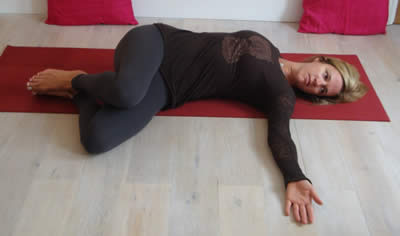
jathara parivarthanasana
ii. Jathara Parivarthanasana, a gentle supine twist beneficial for toning liver, spleen and pancreas. Drop the knees to the right side and breathe. Repeat to the left side. Balances vata, pitta and kapha dosha,
iii. Supine supported backbends soothe vata and pitta dosha. Suptavajrasana (reclining hero pose) stretches the abdomen and improves digestion. Viparita karani (half shoulderstand, against the wall) is known to benefit dyspepsia (contraindicated for glaucoma and high blood pressure). If possible hold these supported postures for 5 minutes.
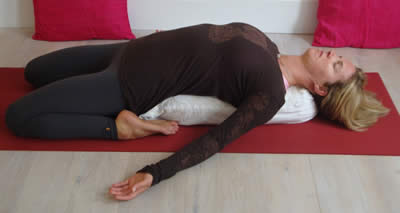
supta vajrasana

supta viparita karani.
C. In restorative postures surrender all effort to allow a deep relaxation and ease vata and pitta.
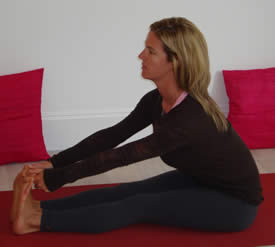
tadagi mudra
D. Tadagi Mudra. Sitting with legs extended out in front of you, grasp the big toes and lengthen spine. Inhale, extend the chest and abdomen out and hold breath for a few seconds. On an exhale completely relax the abdomen. Repeat 6 - 10 times.
E. Avoid forward bends that compress the solar plexus area.
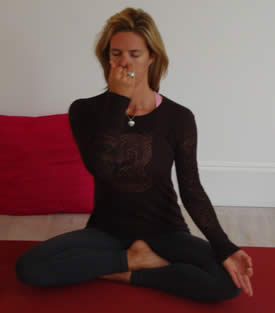
anuloma viloma
F. Pranayama (breathing) practice:
i. Anuloma Viloma (alternate nostril breathing) balances the nervous system and calms the mind.
G. Deep Relaxation and Meditations
i. Savasana (corpse posture) for 10 - 20 minutes to calm the nervous system. Eases vata and pitta.
ii. Direct the breath to any areas of discomfort. Visualize a cooling white light carried by the breath through the entire gastro-intestinal tract, soothing and easing it.
iii. Inhale imagining your breath entering through the middle of the body to the mid-spine where the manipura chakra is located (behind the solar plexus). Retain the breath repeating Ram three times (the mantra for this chakra). Exhale allowing tension to release with your breath and let the whole abdomen relax.
iv. Notice when you are holding your abdomen or solar plexus in tightly in day-to-day activity. Focus on letting go of all muscle tensing in the abdomen with your exhalation.
H. Inner Enquiry
i. Dyspepsia is a manipura (third) chakra condition. Manipura chakra is related to being comfortable with who you are, will and doing. With the psychology of the manipura chakra in mind, in the stillness of deep relaxation, ask this part of your body what it is trying to communicate to you and listen. Every discomfort is a signpost toward greater healing.
ii. Patanjali Maharishi in his Yoga Sutras, invites us to enquire into the root cause of affliction (Yoga Sutras IIvs10). The root cause, from a psycho-spiritual dimension, is invariably avidya (wrong understanding). Whether we enquire into current lifestyle, thinking patterns, injury, shock, or early childhood trauma, we will find wrong conclusion drawn from past experiences, creating limiting beliefs about ourselves, others, and life. The message of illness then facilitates a deeper spiritual healing.
I. Dietary and Lifestyle Advice
The digestive system needs to be fully rested, beginning with fasting or eating only liquid or soft easily digestible, alkalising foods. See a Naturopath or Nutritionist for advice. Eat and sleep at regular times, replace tea and coffee with warm water, reduce stress as far as possible. Sleep with the head raised or on the left side.
Consult a doctor before doing or recommending any of the practices detailed above. It is important to learn yoga practices from a qualified yoga teacher or yoga therapist.
Resources
Gut Reaction: Choose, prepare and combine foods to cleanse your system and revitalise your health. Gudrun Jonsson. Vermilion. 2000.
Yogic Therapy - Its Basic Principles and Methods Swami Kuvalayananda. 2008.
The Practice of Yoga for the Digestive System, Dr Swami Shankardevananda. Yoga Publications Trust. 2003.
Structural Yoga Therapy: Adapting to the Individual. Mukunda Stiles. Red Wheel/Weiser. 2000.
Yoga for Your Type: An Ayurvedic Approach To Asana Practice, Dr D Frawley and Sandra Summerfield Kozak MS. Lotus Press. 2001.
Merec Briefing Issue No. 32, National Prescribing Centre, NHS
www.ayushveda.com/health/dyspepsia
http://expressbuzz.com/LifeStyle/Health/digestive-breathing-for-healthy-digestion/36717.html
Yogic management of ulcers www.webhealthcentre.com/S_altmedicine/yoga/yoga_mgmt.aspx
Comments:
-
No Article Comments available